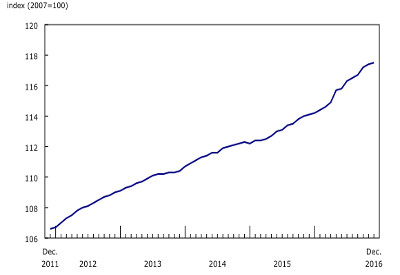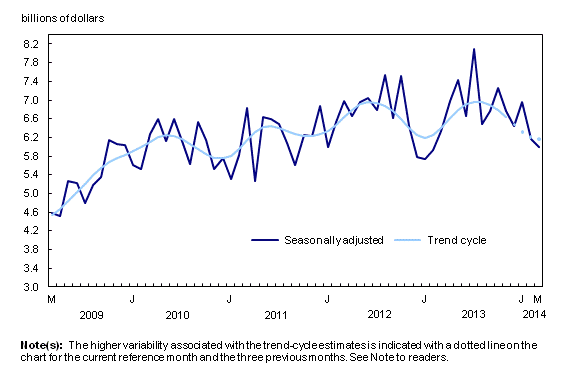Labour Force Survey, March 2025

April 11, 2025
Employment fell by 33,000 (-0.2%) in March and the employment rate declined 0.2 percentage points to 60.9%. The unemployment rate rose 0.1 percentage points to 6.7%.
In March, employment declined among men aged 55 years and older (-21,000; -0.9%) while there was little change for other major demographic groups.
Employment declined in wholesale and retail trade (-29,000; -1.0%), as well as information, culture and recreation (-20,000; -2.4%). There were increases in the ‘other services’, such as personal and repair services (+12,000; +1.5%) and utilities (+4,200; +2.8%).
Employment fell in Ontario (-28,000; -0.3%) and Alberta (-15,000; -0.6%), while it increased in Saskatchewan (+6,600; +1.1%). Employment was little changed in the other provinces in March.
Total hours worked rose 0.4% in March, following a decline of 1.3% in February. On a year-over-year basis, total hours worked were up 1.2%.
Average hourly wages among employees were up 3.6% (+$1.24 to $36.05) on a year-over-year basis in March, following growth of 3.8% in February (not seasonally adjusted).
Employment falls in March
Employment decreased by 33,000 (-0.2%) in March, the first decrease since January 2022. The decline in March followed little change in February and three consecutive months of growth in November, December and January totaling 211,000 (+1.0%).
The employment decline in March was driven by a drop in full-time work (-62,000; -0.4%). Full-time employment had followed a strong upward trend in the second half of 2024 and had held steady in January and February 2025.
The employment rate—the proportion of the population aged 15 and older who are employed—fell 0.2 percentage points to 60.9% in March. This partially offset an increase of 0.3 percentage points that had been observed from October 2024 to January 2025.
Chart 1
Employment rate falls in March

Private sector employment fell by 48,000 (-0.3%) in March, following little change in February and a cumulative increase of 97,000 (+0.7%) from November 2024 to January 2025. On a year-over-year basis, the number of employees in the private sector was up by 175,000 (+1.3%).
Public sector employment was little changed for a third consecutive month in March and was up 92,000 (+2.1%) compared with a year earlier. Self-employment was also little changed in March and was up 81,000 (+3.0%) on a year-over-year basis.
Employment declines among men aged 55 and older
Employment fell by 21,000 (-0.9%) among men aged 55 years and older in March, bringing the cumulative decline for this group since the beginning of the year to 47,000 (-1.9%). The employment rate for men aged 55 and older fell 0.4 percentage points to 38.8% in March, the third consecutive monthly decline. Among women aged 55 and older, the employment level and the employment rate were both little changed in March.
Infographic 1
Employment rate by age group, March 2025

Among core-aged men (25 to 54 years old), employment edged down (-16,000; -0.2%) in March and the employment rate fell 0.4 percentage points to 86.3%. Employment held steady in March among core-aged women, and the employment rate for this group was little changed at 80.5%.
In March, employment was little changed for youth (aged 15 to 24). On a year-over-year basis, the employment rate was down for both young women (-1.3 percentage points to 54.6%) and young men (-1.0 percentage points to 53.4%).
Unemployment rate rises to 6.7%
The unemployment rate rose 0.1 percentage points to 6.7% in March, the first increase since November 2024. The unemployment rate had trended up from 5.0% in March 2023 to a recent high of 6.9% in November 2024, before falling by 0.3 percentage points from November 2024 to January 2025, in the context of robust employment growth at the end of 2024 and in early 2025.
Chart 2
Unemployment rate increases to 6.7% in March

Infographic 2
Unemployment rate by age group, March 2025

Since March 2024, the unemployment rate has remained above its pre-COVID-19 pandemic average of 6.0% (from 2017 to 2019).
In March 2025, the unemployment rate rose among women aged 15 to 24 (+1.4 percentage points to 13.1%), as more young women looked for work. The unemployment rate was little changed across other major demographic groups.
Unemployed people face more difficulties finding work in March compared with a year earlier
In total, there were 1.5 million unemployed people in March, up 36,000 (+2.5%) in the month and up 167,000 (+12.4%) on a year-over-year basis.
Among those who were unemployed in February, 14.7% became employed in March. This was lower than the corresponding proportion in March 2024 (18.6%) (not seasonally adjusted).
Long-term unemployment has also risen; the proportion of unemployed people searching for work for 27 weeks or more stood at 23.7% in March 2025, up from 18.3% in March 2024.
People may become unemployed following a job loss, or after voluntarily leaving a job. Others may not have worked recently, either because they are new entrants to the labour market, or because they have been without a job for a longer period.
Among the 1.5 million people who were unemployed in March, the largest share (44.1%) had lost their job due to a lay-off within the previous 12 months (down from 47.0% in March 2024) (not seasonally adjusted). Of these unemployed people, 18.4% last worked in construction, while 12.4% last worked in wholesale or retail trade. The proportion of the unemployed who last worked in manufacturing (9.3%) was little changed on a year-over-year basis.
Another 41.5% of unemployed people in March had not worked in the previous 12 months (or had never worked). This proportion was up from 35.4% in March 2024. People in this group may be more vulnerable to variations in labour market conditions and are generally not eligible to receive regular Employment Insurance benefits.
A further 14.3% of those who were unemployed in March had voluntarily left their previous job, down from 17.6% in March 2024. Reasons for leaving a job and searching for a new one may include dissatisfaction, going to school, or caring for family members.









